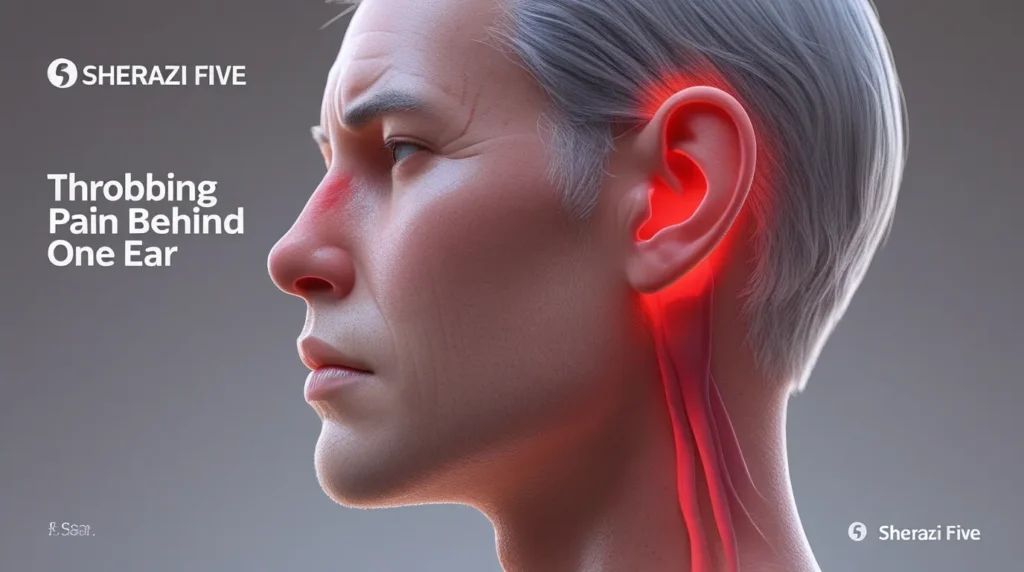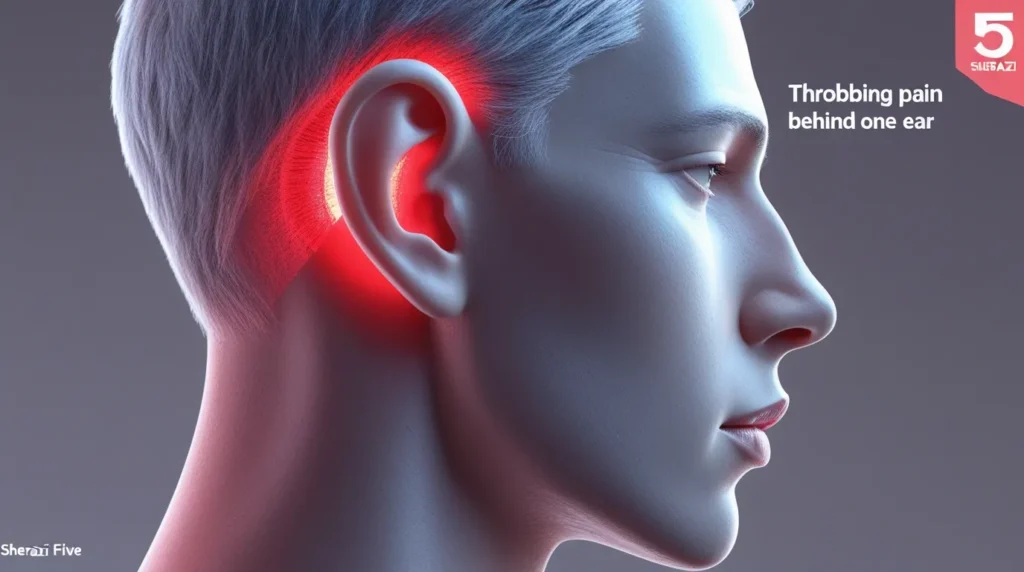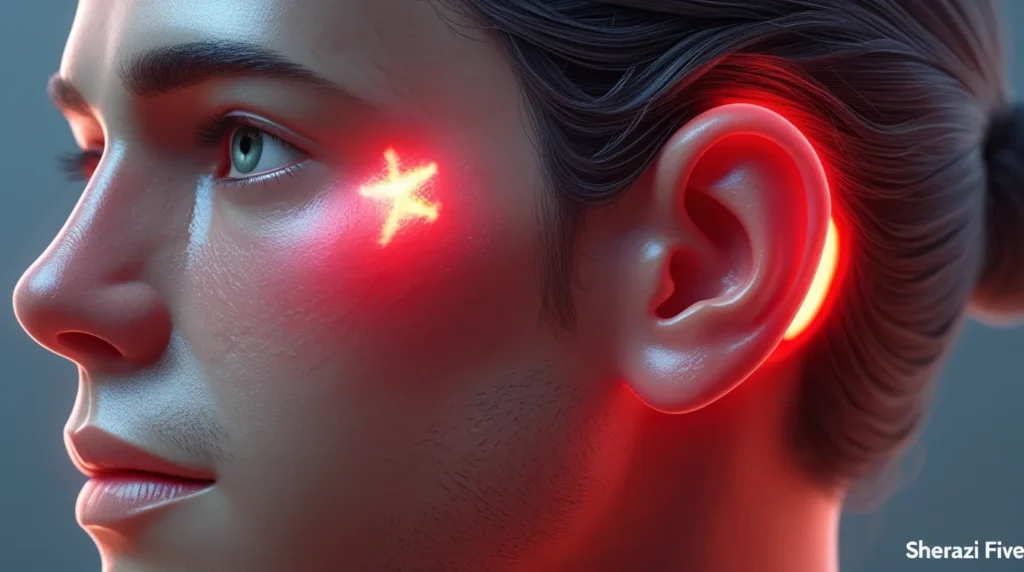Experiencing throbbing pain behind one ear can be both alarming and disruptive to daily life. Many people describe it as a pulsing or pounding sensation that may come and go or persist for hours. This discomfort is often linked to conditions such as an ear infection, temporomandibular joint pain (TMJ), or even swollen lymph nodes.
In some cases, the pain may extend to the jaw or trigger a headache behind ear, making it hard to concentrate or rest. Understanding the possible causes, symptoms, and treatments is the first step toward finding effective ear pain relief and preventing complications.
What is Throbbing Pain Behind One Ear?
Feeling a throbbing pain behind one ear can be uncomfortable and worrying. It often feels like a rhythmic pulsing or pressure that makes it hard to focus on daily tasks. Unlike a simple earache, this sensation may point to deeper health concerns.
Sometimes the pain comes suddenly, while in other cases it develops slowly. Many people describe it as sharp ear pain or pulsating ear pain that worsens with movement. Understanding this type of discomfort is important so you can take steps for the right treatment.
Common Causes of Throbbing Pain Behind One Ear

The most common reason for a throbbing pain behind one ear is an ear infection. Fluid trapped in the middle ear builds pressure, leading to pain and swelling. Another cause is temporomandibular joint pain (TMJ), which often radiates toward the ear.
Other possible triggers include mastoiditis, swollen lymph nodes, or even stress-related tension. In some cases, ear discomfort comes from ear pressure caused by altitude changes or sinus blockages. Each cause needs different care and attention.
Symptoms to Watch For
Besides the throbbing pain itself, you may also notice other signs. A headache behind ear, dizziness, or ringing in the ear can appear. Many people also experience jaw pain, making it harder to chew or talk.
Red-flag symptoms include swelling, fever, or discharge from the ear. These signs suggest more than simple ear discomfort and may point to infection or another medical issue. Always watch closely if pain becomes constant or more intense.
How Ear Infections Cause Pain

An ear infection happens when bacteria or viruses trap fluid in the middle ear. This creates inflammation and pressure that leads to throbbing pain behind one ear. In children, infections are even more common, but adults can also suffer.
If untreated, infections may turn into chronic earache or spread to nearby structures. Doctors often recommend antibiotics, pain relievers, or warm compresses to help. Early treatment prevents complications and keeps the sharp ear pain from worsening.
TMJ and Jaw-Related Causes
The temporomandibular joint (TMJ) connects your jaw to the skull. When it becomes inflamed or stressed, it can cause jaw pain that feels like ear discomfort. Teeth grinding, stress, or injury often trigger this condition.
Many patients confuse TMJ with ear pain, since the ache spreads near the ear canal. Relaxation exercises, mouth guards, or physical therapy can ease this type of pulsating ear pain. Treating TMJ can quickly reduce the throbbing.
Other Medical Conditions

Though less common, serious conditions can lead to throbbing pain behind one ear. Mastoiditis, an infection of the bone behind the ear, causes swelling, fever, and severe pain. It requires urgent medical treatment.
Nerve-related issues and sinus infections can also create pain radiating from ear. While these are rare, ignoring symptoms may worsen them. Always seek medical help if you notice unusual swelling or continuous discomfort.
Home Remedies and Pain Relief
For mild cases, simple remedies can bring comfort. A warm compress applied to the ear often soothes ear discomfort. Over-the-counter medications also help reduce swelling and pain.
Relaxation techniques like deep breathing or stretching can ease jaw pain linked to TMJ. Some find relief by resting in a quiet, dark room when headache behind ear occurs. However, avoid inserting objects into your ear for self-treatment.
When to See a Doctor
You should not ignore a throbbing pain behind one ear if it lasts longer than a few days. If fever, swelling, or discharge appear, seek medical care immediately.
Persistent one-sided ear pain may signal infection, mastoiditis, or another issue needing urgent treatment. Only a doctor can decide the best therapy and prevent further complications.
Diagnosis and Medical Treatments
Doctors usually begin with a physical exam to check the ear canal. Imaging or lab tests may follow if needed. For infections, antibiotics or antiviral medications are prescribed. For TMJ pain, therapy or special bite guards may help.
In severe cases, surgery might be required, especially with mastoiditis or chronic infection. ENT specialists provide the most accurate diagnosis, ensuring safe and effective treatment for throbbing pain behind one ear.
Preventive Measures

Prevention often reduces the risk of future ear pain. Practicing good ear hygiene lowers the chance of ear infection. Avoiding loud noise, stress, and teeth grinding can protect against TMJ pain.
Maintaining overall health is important too. Strong immunity helps the body fight infection and reduces chronic earache risks. Small lifestyle changes go a long way in keeping your ears healthy.
H3: Chronic vs. Temporary Pain
A chronic earache lasts for weeks or keeps returning, while temporary pain may fade in a few days. Knowing the difference helps you decide if you need home care or medical attention. Continuous discomfort should never be ignored.
Table: Quick Comparison of Causes and Symptoms
| Cause | Main Symptom | Additional Signs | Treatment Options |
|---|---|---|---|
| Ear Infection | Pulsating ear pain | Fever, fluid, dizziness | Antibiotics, pain relievers |
| TMJ Disorder | Jaw pain near ear | Clicking, stress, teeth grinding | Therapy, guards, relaxation |
| Mastoiditis | Severe pain behind ear | Swelling, fever | Urgent antibiotics, surgery |
| Sinus Infection | Headache behind ear | Congestion, pressure | Decongestants, antibiotics |
| Swollen Lymph Nodes | Local tenderness | Sore throat, fatigue | Medical evaluation |
Conclusion
Living with throbbing pain behind one ear can affect work, sleep, and peace of mind. Most cases come from ear infections, TMJ disorders, or minor issues. But serious conditions like mastoiditis require quick attention.
If the pain continues or worsens, don’t wait. Get professional advice to identify the real cause. Early care ensures better outcomes and lasting ear pain relief. By understanding symptoms and treatments, you can manage your health and prevent future problems.




